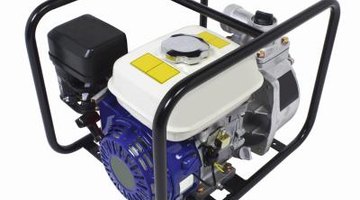How to Back-Feed My Electrical Panel
Backfeeding a generator into your home's wiring is safe, provided you do it correctly. Although considered a temporary measure, backfeeding is useful when threatened unexpectedly with a power outage, and emergency power is needed on tap. Using extension cords and the process of elimination, you can keep key outlets working to power lighting and necessary appliances.

Step 1
Shut off the main power breakers at your electrical panel. Look for a section labeled "Main" and larger breaker units starting with 100 amps and moving up, often located at the top of your panel.
Step 2
Find a suitable spot for your generator. Ensure it is protected from the elements while maintaining proper ventilation of the fumes it produces when in use.
Step 3
Shut off the rest of your breakers. Make a divided list on your notepad, with one column as "Circuit A" and the other "Circuit B."
Step 4
Plug one of the extension cords into one of the outlets on the generator. Find an outlet close to the generator. Plug the other end of the cord into this.
Step 5
Turn on the generator. Allow a few minutes for it to reach normal operating temperature. Turn on each 15 and 20 amp breaker only, waiting at least five seconds between each activation.
Step 6
Stick the tip of the AC power detector pen into the slot on each outlet, while you walk around the house with your notepad. Make a note on your pad indicating which outlets are functional at this point. Turn off the generator and unplug the extension cord at both ends.
Step 7
Plug a second cord into the second outlet on the generator. Plug the other end into the closest outlet that proved non-functional during the previous sweep of the home. This is Circuit B.
Step 8
Plug the first extension cord back into the first outlet used to test your circuits. The panel and generator is ready to back up your home in case of an outage.
References
Tips
- Always activate larger breakers last, such as those powering refrigerators.
- Use the shortest possible extension cords to minimize power drop.
Warnings
- Be sure you know how much power the generator can produce under load. Generally, 1,000 watts is equivalent to eight amps.
Writer Bio
David Lipscomb is a professional writer and public relations practitioner. Lipscomb brings more than a decade of experience in the consumer electronics and advertising industries. Lipscomb holds a degree in public relations from Webster University.
Photo Credits
- Stockbyte/Stockbyte/Getty Images
More Articles



